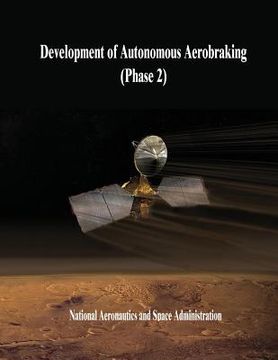Reseña del libro "Development of Autonomous Aerobraking (Phase 2) (en Inglés)"
Phase 1 of the Development of Autonomous Aerobraking (AA) Assessment investigated the technical capability of transferring the processes of aerobraking maneuver (ABM) decision making (currently performed on the ground by an extensive workforce and communicated to the spacecraft via the deep space network (DSN) to an efficient flight software algorithm onboard the spacecraft. To accomplish this, aerodynamic and thermal models for a representative spacecraft were developed for the onboard algorithm known as AA development software (AADS) and a ground-based "truth" simulation developed for testing purposes. An autonomous ephemeris, atmosphere estimator (AE), and maneuver estimator (ME) were also developed and incorporated into the AADS. Previous aerobraking mission experience indicated that an increase in the error of the predicted time of periapsis passage requires frequent (daily) ephemeris updates from the ground using DSN. The Phase 1 simulation analysis of AADS demonstrated the algorithm could provide state estimates within the previously accepted 250-second periapsis timing error for more than a week before requiring a ground update, thus eliminating the need for continuous DSN coverage. AADS was tested in simulation at three destinations, Mars, Venus, and Titan, and included atmospheric perturbations and sensor (inertial measurement unit (IMU)) measurement errors. This document describes Phase 2 of this study, which was a 12-month effort to improve and rigorously test the AADS developed in Phase 1. Model improvements included rewriting the Phase 1 ephemeris estimator (EE) model, which is called the state propagator (SP) in Phase 2 to more easily accommodate flight software structures and leverage existing flight software architectures. The AE was modified to include the prediction of atmospheric density uncertainty, which was incorporated into the maneuver decision logic. The AADS simulation environment, the Program to Optimize Simulated Trajectories (POST2), was upgraded, decreasing run time and increasing simulation capability. Dispersion analysis, using statistical Monte Carlo approaches and error uncertainties, was performed to more accurately measure the operability of using AA in a perturbed environment. Additionally, initial assessments of the spacecraft dynamic dispersions were evaluated using a 6 degree-of-freedom (6-DOF) simulation. Trade studies were assessed with the SP and introduced the option of using AeroNAV, an onboard orbit determination (OD) tool that incorporates functionality not currently modeled in AADS, such as fault tolerances, orbit safing approaches, and sequence timing information. Studies also provided first order analysis of the onboard computational resources required by the software. Finally, the improved AADS performance was assessed by its ability to reproduce the Mars Odyssey (ODY) and Reconnaissance Orbiter (MRO) aerobraking missions and its performance in an ODY-like aerobraking mission operational readiness test (ORT). The extensive Phase 2 testing verified that the AADS algorithms were accurate, robust, and ready to be considered for application to future missions that utilize aerobraking and has extended the technology readiness level (TRL) to between five and six.

